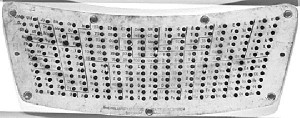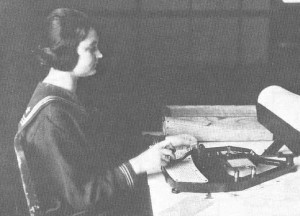 Neptune was almost discovered by Galileo, but he mistook it for a star. Lalande, a French astronomer who created tables of the planetary positions also recorded Neptune’s position but also thought it was a star. One of the people responsible for discovering Uranus, John Herschel, also thought that it was a star. When Delambre was computing tables of Uranus, he discovered discrepancies in the position. He noted that there were discrepancies. During his time at Cambridge, John Couch Adam decided to begin investigating the irregularities of Uranus’ orbit. At relatively the same time, a French astronomer Urbain Jean Joseph Le Verrier also recognized the irregularities in the orbit of Uranus and thought this was due to an undiscovered planet. He then did computations based upon Newton’s gravitational laws and deduced the location of the undiscovered planet. Le Verrier gave his calculations to Johann Gottfried Galle who discovered the planet Uranus.
Neptune was almost discovered by Galileo, but he mistook it for a star. Lalande, a French astronomer who created tables of the planetary positions also recorded Neptune’s position but also thought it was a star. One of the people responsible for discovering Uranus, John Herschel, also thought that it was a star. When Delambre was computing tables of Uranus, he discovered discrepancies in the position. He noted that there were discrepancies. During his time at Cambridge, John Couch Adam decided to begin investigating the irregularities of Uranus’ orbit. At relatively the same time, a French astronomer Urbain Jean Joseph Le Verrier also recognized the irregularities in the orbit of Uranus and thought this was due to an undiscovered planet. He then did computations based upon Newton’s gravitational laws and deduced the location of the undiscovered planet. Le Verrier gave his calculations to Johann Gottfried Galle who discovered the planet Uranus.
According to many stories, and as stated in Jacquard’s Loom, the reason why the planet was not discovered due to Adam’s calculations was because “[i]nstead of instigating a major telescopic search that would almost certainly have resulted in the discovery of the new planet, Neptune, Airy chose not to act on Adam’s information.” (104). Due to Airy overlooking Adam’s calculations, it was decided that Adams and Le Verrier needed equal credit in the discovery of Neptune. However, according to the Neptune file, found again in 1998, this is not the full story.
In the file it is revealed that instead of being ignored by Airy, Adams was actually vague and inconsistent in his planetary position. Adam’s predictions ranged over 20 degrees of the sky, and after the planet was searched for during six-weeks at the Cambridge University Observatory was still not found. This was far different than Le Verrier’s calculations, which were one degree off of the actual planet’s location. Galle found the planet in half an hour. From Adam’s journal transcriptions, it shows “him still working on a problem which (one gathers) it was first necessary to solve in order to achieve a full solution.” (Kollerstrom, 5.42). After Galle’s discovery based on Le Verrier’s prediction, British astronomers contrived a selected story of events. Only Adam’s more accurate mathematical results were made public and made to appear as if Adam’s had the predicted the exact location of the planet. While Le Verrier protested at the time, it was in vain. He became very bitter about the lack of recognition for his work.
If there was a difference machine to facilitate in Le Verrier’s calculations, I feel that he would have predicted the location of the planet quicker. While a difference machine would also help Adam, it was shown that his earlier calculations were more accurate than his later ones. For this reason I suspect that Adam’s predictions would have just become continually worse. From this, I feel that Le Verrier would be proven as the true discoverer of Neptune, and Adam would be recognized for his calculations and work to discover the location of the planet, but wouldn’t be considered a co-discoverer.
If it had not been for the lack of recognition of his discovery, I feel that Le Verrier would have been a more likeable person and wouldn’t have been so unpopular. This would have resulted in a more productive appointment as director of the Paris Observatory and probably would not have ended in him being overthrown and when later reinstated, stripped of most of his authority. This productive appointment would have led to more astronomical discoveries. This amount of astronomical discoveries would have caused Paris to be a center of astronomical discovery.
One such astronomical discovery, I feel, would have happened sooner is the discovery of Pluto. Since Le Verrier had already done work on the orbit of Neptune, I feel that if the orbit of Neptune would have continued to be tracked Le Verrier would have discovered perturbations in the orbit due to the planet Pluto. Such perturbations would have been linked through Newtonian orbital theory, which could have been further developed by Le Verrier if his view on Newtonian orbital theory had not been poisoned by his lack of recognition for the discovery of Neptune. Such an early discovery of Pluto would give it historical significance as a planet, and perhaps its planetary status would not have been taken away.
Sources:
Coimbra, Miguel. “Neptune – God of the Seas and Oceans.” Web. 12 Oct. 2011. <http://www.miguelcoimbra.com/images/gallery2.php?bimg=galerie/books/2romans/neptune.jpg&l=820&h=820>
Essinger, James. Jacquard’s Web. New York: Oxford University Press, 2002. Print.
Kollerstrom, Nicholas. “Recovering the Neptune Files.” RAS Research (2003): 5.23-5.24. Web. 12 Oct. 2011. <http://www.dioi.org/kn/neptunefile.pdf>
O’Connor, John, and Edmund Robertson. “Neptune and Pluto.” The MacTutor History of Mathematics archive. University of St Andrews. Sept. 1996. Web. 12 Oct. 2011. <http://www-history.mcs.st-and.ac.uk/HistTopics/Neptune_and_Pluto.html>
O’Connor, John, and Edmund Robertson. “Urbain Jean Joseph Le Verrier.” The MacTutor History of Mathematics archive. University of St Andrews. Dec. 1996. Web. 12 Oct. 2011. <http://www.gap-system.org/~history/Biographies/Le_Verrier.html>
“Portrait of John Couch Adams.” DSpace. University of Cambridge. 2008. Web. 12 Oct. 2011. <http://www.dspace.cam.ac.uk/handle/1810/214762>
Sheehan, William. “Secret Documents Rewrite the Discovery of Neptune.” Social Sky & Telescope: The Essential Magazine of Astronomy (2003): n. pag. Web. 12 Oct. 2011. <http://www.skyandtelescope.com/news/3307531.html>
“Urbain Le Verrier.” Random Knowledge. WordPress. 11 Mar. 2008. Web. 12 Oct 2011. <http://randomknowledge.wordpress.com/2008/03/11/urbain-le-verrier/>
William, David. “Neptune Fact Sheet”. Planetary Fact Sheets. NASA. Nov. 2010. Web. 12 Oct. 2011. <http://nssdc.gsfc.nasa.gov/planetary/factsheet/neptunefact.html>









